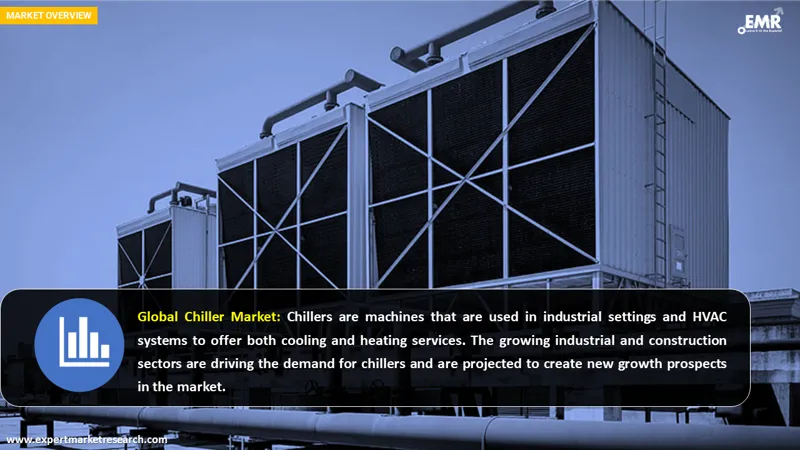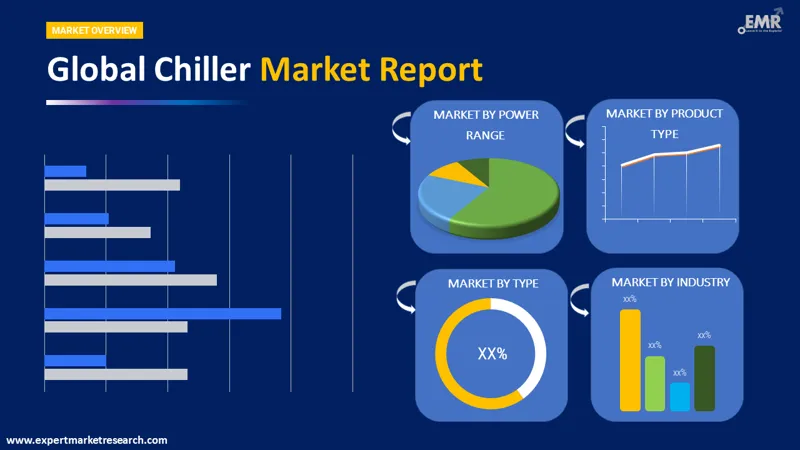
Consumer Insights
Uncover trends and behaviors shaping consumer choices today
Procurement Insights
Optimize your sourcing strategy with key market data
Industry Stats
Stay ahead with the latest trends and market analysis.
The global chiller market size reached a value of more than USD 11.85 Billion in 2025. The market is expected to grow at a CAGR of 3.90% between 2026 and 2035, likely to attain a value of USD 17.37 Billion by 2035.
Base Year
Historical Period
Forecast Period
Compound Annual Growth Rate
3.9%
Value in USD Billion
2026-2035
*this image is indicative*
Chillers refer to the type of machine that is utilized in industrial fields and HVAC systems to provide cooling and heating services. It circulates coolant around the chiller to remove the heat from a target object. After the heat is absorbed by the coolant, it then goes through cooling process where outside water or air is taken to reduce the temperature of the coolant. The coolant that has cooled down is then reused to cool the target object, creating a loop that provides continuous cooling of the target object.

Read more about this report - REQUEST FREE SAMPLE COPY IN PDF
Increasing Demand for Cooling Form Different Industries
Industrial operations produce a lot of heating due to friction between components in high powered equipments, making chiller units necessary to ensure the proper functioning of an equipment. The increasing industrial activities has propelled the demand for chiller systems, enhancing the market growth.
Rising Adoption of Chiller Systems in Food and Beverage Industry
The food production industry has been increasingly implementing chilling machines due to rising consumption of frozen and packaged foods. During the processing of products, a lot of heat is generated, and it is essential to remove the heat so the product can be stored in a proper form.

Read more about this report - REQUEST FREE SAMPLE COPY IN PDF
The EMR’s report titled “Chiller Market Report and Forecast 2026-2035” offers a detailed analysis of the market based on the following segments:
Market Breakup by Type
Market Breakup by Product Type
Market Breakup by Power Range
Market Breakup by Industry
Market Breakup by Region
Based on types, the market bifurcations include screw, scroll, and centrifugal, among others. Among these segments, centrifugal chillers are expected to hold a significant share of the market, owing to their increased utilisation because of their low maintenance and manufacturing costs.
Centrifugal chillers are cooling systems that utilise a vapour compression cycle to cool down by collecting heat from one water loop and compressor to a second water loop that is cooled by a cooling water tower. It is capable of providing high capacity while maintaining excellent energy efficiency.
Based on industries, the market can be segmented into food and beverage, plastic and rubber, chemicals and petrochemicals, and pharmaceuticals, among others.
The plastic and rubber industry is expected to hold a significant share of the market owing to the increasing utilization of plastic products across various applications in the plastic industry. Companies have also started to increase the implementation of Chillers to cool down the equipment used in the manufacturing process. The rising demand from this industry will significantly help market growth.
The food and beverage industry follows the plastic and rubber industry with a rapid growth rate which can be attributed to the increasing consumption of frozen food. They are utilized to draw the heat away from products after various processes including mixing, cooking, or fermentation, among other processes.
The comprehensive EMR report provides an in-depth assessment of the market based on Porter's five forces model along with giving a SWOT analysis. The report gives a detailed analysis of the following key players in the global chillers industry, covering their competitive landscape and the latest developments like mergers, acquisitions, investments and expansion plans.
Carrier Global Corporation is a multinational company specializing in HVAC systems, refrigeration, and fire and security equipment. The company was founded in 1915 and it headquarter is located in Florida, United States.
Daikin Industries, Ltd. is a Japanese multinational company, leading in the air conditioner manufacturing market. The company’s products and services include control systems, air-cooled chillers, water-cooled chillers, ventilation, and refrigeration, among many other different products. The company was founded in 1924 and is headquartered in Osaka, Japan.
LG Electronics is a South Korean multinational conglomerate engaged in computer and electronics manufacturing. It is the largest family-owned business in South Korea headquartered in Seoul, South Korea, and it was founded in 1947. The company has a wide variety of products including home appliances, wearable devices, monitors, and cooling systems including chillers of multiple types including centrifugal chiller, screw and scroll chiller, and absorption chiller.
*Please note that this is only a partial list; the complete list of key players is available in the full report. Additionally, the list of key players can be customized to better suit your needs.*
Other market players include Panasonic Corporation, Smardt Chiller Group, Inc., and Mitsubishi Electric Corporation, among others.




*While we strive to always give you current and accurate information, the numbers depicted on the website are indicative and may differ from the actual numbers in the main report. At Expert Market Research, we aim to bring you the latest insights and trends in the market. Using our analyses and forecasts, stakeholders can understand the market dynamics, navigate challenges, and capitalize on opportunities to make data-driven strategic decisions.*
Get in touch with us for a customized solution tailored to your unique requirements and save upto 35%!
In 2025, the global market for chillers reached a value of USD 11.85 Billion.
The market is expected to grow at a CAGR of 3.90% during the period 2026-2035.
The market is expected to reach a value of USD 17.37 Billion by 2035.
The market is driven by the growing demand for chillers in manufacturing industries to cool down equipment used in the manufacturing process and the rising demand for energy-efficient chillers.
The increasing industrial and construction activities are leading to increased demand for chillers and are expected to bring new growth opportunities to the market.
The regional markets for the global chiller market include North America, Europe, the Asia Pacific, Latin America, the Middle East and Africa.
The types of chillers available in the market include screw, scroll, and centrifugal, among others.
The product types available in the market include air-cooled and water-cooled, among others.
The different power ranges for chiller in the market are less than 50 kW, 50-200 kW, and more than 200 kw.
The industries utilizing chillers include food and beverage, plastic and rubber, chemicals and petrochemicals, and pharmaceuticals, among others.
The key players in the market include Carrier Global Corporation, Daikin Industries, Ltd., LG Electronics, Panasonic Corporation, Smardt Chiller Group, Inc., and Mitsubishi Electric Corporation, among others.
Explore our key highlights of the report and gain a concise overview of key findings, trends, and actionable insights that will empower your strategic decisions.
| REPORT FEATURES | DETAILS |
| Base Year | 2025 |
| Historical Period | 2019-2025 |
| Forecast Period | 2026-2035 |
| Scope of the Report |
Historical and Forecast Trends, Industry Drivers and Constraints, Historical and Forecast Market Analysis by Segment:
|
| Breakup by Type |
|
| Breakup by Product Type |
|
| Breakup by Power Range |
|
| Breakup by Industry |
|
| Breakup by Region |
|
| Market Dynamics |
|
| Competitive Landscape |
|
| Companies Covered |
|
Datasheet
One User
USD 2,499
USD 2,249
tax inclusive*
Single User License
One User
USD 3,999
USD 3,599
tax inclusive*
Five User License
Five User
USD 4,999
USD 4,249
tax inclusive*
Corporate License
Unlimited Users
USD 5,999
USD 5,099
tax inclusive*
*Please note that the prices mentioned below are starting prices for each bundle type. Kindly contact our team for further details.*
Flash Bundle
Small Business Bundle
Growth Bundle
Enterprise Bundle
*Please note that the prices mentioned below are starting prices for each bundle type. Kindly contact our team for further details.*
Flash Bundle
Number of Reports: 3
20%
tax inclusive*
Small Business Bundle
Number of Reports: 5
25%
tax inclusive*
Growth Bundle
Number of Reports: 8
30%
tax inclusive*
Enterprise Bundle
Number of Reports: 10
35%
tax inclusive*
How To Order

Select License Type
Choose the right license for your needs and access rights.

Click on ‘Buy Now’
Add the report to your cart with one click and proceed to register.

Select Mode of Payment
Choose a payment option for a secure checkout. You will be redirected accordingly.
Gain insights to stay ahead and seize opportunities.

Get insights & trends for a competitive edge.

Track prices with detailed trend reports.

Analyse trade data for supply chain insights.

Leverage cost reports for smart savings

Enhance supply chain with partnerships.

Connect For More Information
Our expert team of analysts will offer full support and resolve any queries regarding the report, before and after the purchase.
Our expert team of analysts will offer full support and resolve any queries regarding the report, before and after the purchase.
We employ meticulous research methods, blending advanced analytics and expert insights to deliver accurate, actionable industry intelligence, staying ahead of competitors.
Our skilled analysts offer unparalleled competitive advantage with detailed insights on current and emerging markets, ensuring your strategic edge.
We offer an in-depth yet simplified presentation of industry insights and analysis to meet your specific requirements effectively.
Share